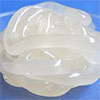| Feb 15, 2022 |
|
|
|
(Nanowerk News) Self-assembling protein molecules are versatile materials for medical applications because their ability to form gels can be accelerated or retarded by variations in pH, as well as changes in temperature or ionic strength. These biomaterials, responsive to physiological conditions, can therefore be easily adapted for applications where their effectiveness depends on gelation kinetics, such as how quickly and under what stimuli they form gels.
|
|
Understanding gelation kinetics for protein hydrogels is important for assessing their utility in medical applications and in the future of biomaterials. For example, fast-gelling systems are clinically useful for in situ gelation for the delivery of drugs or genetic material to target cells or anatomic regions, while slower-gelling systems are applicable for tissue engineering because of their ability to maintain cell viability and their propensity to maintain homogeneity.
|
|
To study these dynamics, the NYU Tandon researchers led by Jin Kim Montclare, professor of chemical and biomolecular engineering, used passive microrheology (versus measuring flow behavior through active application of pressure) to extend on earlier research into the phase behavior of gelating protein-based macromolecules. The earlier study investigated different environmental conditions, principally temperature changes — in part to determine the upper temperature point at which the gels disassociate into constituent macromolecules.
|
|
In the new study, appearing in the ASC journal Macromolecules (“High-Throughput Microrheology for the Assessment of Protein Gelation Kinetics”), the team found, among other findings, that using a pH near the isoelectric point of the protein results in the electrostatic repulsions being minimized, which allows for self-assembly and gelation. They found that the same effect can be induced by increasing the ionic strength to screen any electrostatic repulsions that are present.
|
|
“This is important insight in developing gel materials for tissue engineering and drug delivery since the tissue microenvironment has specific pH and ionic strength,” said Montclare, who directs the Montclare Lab at NYU Tandon, and whose study co-authors are Michael Meleties, principal author and Ph.D. candidate; Dustin Britton, a Ph.D. candidate; Priya Katyal, a postdoctoral researcher; Bonnie Lin, an undergraduate research assistant; and collaborators from the Air Force Research Lab Rhett L. Martineau and Maneesh K. Gupta.
|
|
She pointed out that microrheology can be done in high throughput to rapidly assess self-assembly/gelation kinetics of a number of samples in parallel, as opposed to screening individual samples one after the other, which can be time-consuming.
|
|
“This can now allow biomaterials researcher to screen a large number of different engineered materials to accelerate biomaterials design,” she said.
|
